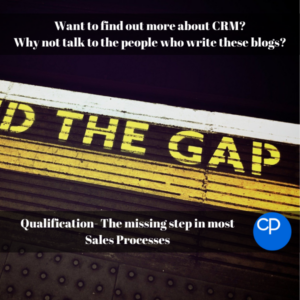Reading Time: 2min40s
 A sales team’s ability to effectively qualify leads is one of the most important aspects of any sales process, now more than ever. Time has always been valuable, during times of steep change, time is even more valuable. Misqualified opportunities will ruin any sales process. An understanding of whether there is genuine interest or if what you have is just a name and a phone number is critical to ensuring that no time is wasted. Asking the right questions will go a long way in ensuring that your qualification process is airtight and that the right amount of time is spent on the right prospects.
A sales team’s ability to effectively qualify leads is one of the most important aspects of any sales process, now more than ever. Time has always been valuable, during times of steep change, time is even more valuable. Misqualified opportunities will ruin any sales process. An understanding of whether there is genuine interest or if what you have is just a name and a phone number is critical to ensuring that no time is wasted. Asking the right questions will go a long way in ensuring that your qualification process is airtight and that the right amount of time is spent on the right prospects.
A recent newsletter received by me and the team at Collier Pickard had some interesting points about prospects. According to the newsletter, 92% of interested buyers reply within a 14-day window and the vast majority of those reply within two days of the most recent message.
As long as the marketing efforts are producing qualitative leads for the sales team to qualify, I agree with the points expressed in the newsletter. It is the qualification process that is the most vital, as your team goes through the motions of the process, they should be able to identify cohorts of equally unqualified people. These cohorts will have similar reservations or difficulties and this alignment means that your team can use blanket tactics on groups of people. I will be discussing different lead qualification methodologies that we use and the groups of cohorts that we have recognised.
Lead Qualification Methodologies
There are a number of methodologies used by sales teams to qualify leads effectively and efficiently. Some of the more recognizable methodologies include:
- MAN- Money, Authority and Need
- SCOTSMAN- Solution, Competition, Originality, Time, Size, Money, Authority and Need
- ChAMP- Challenges, Authority, Money, and Prioritization
- ANUM- Authority, Need, Urgency and Money
- FAINT- Funds, Authority, Interest, Need and Timeline
- NEAT- Need, Economic Impact, Authority and Timeline
- BANT- Budget, Authority, Need and Timeline
- NOTE- Need, Opportunity, Team and Effect
All of the above methodologies cover the same 4 critical criteria that is needed to qualify a lead. Do they have the Need? Is there a Budget in place? Does the contact have the Authority to access the budget? What are the Timelines involved? Having a keen understanding of all 4 of these key criteria vastly improves our success rate when it comes to closing new business.
Effective qualification of leads is an art form, it is the ability to leap from our own methodology into that of our clients. When you have spent the amount of time that we have (almost three decades) qualifying prospects, you start to notice patterns. The mindset of cohorts will fall neatly into 1 of 3 categories.
Hot!
The prospect has done the research. All 4 pieces of the qualification criteria are present. There is a budget in place, the contact has the authority to access that budget, the research done means that the need has been defined and a deadline is in place. This type of cohort knows what they want and they want it from us.
Build Trust
Cohorts that fall into this category lack one of our key qualification criteria. It could be that there is not enough budget, so we help them to see value in our proposal. Perhaps the prospect lacks the sufficient authority to purchase, here we will help our prospective client develop arguments that they can use to convince management. The prospect may tell us that there is not a big enough need to justify the project, so we show them how a CRM system could be used in other areas of the business. If we can understand our clients buying process it will be easier to use our selling process/methodology to build the trust necessary to drive the sale to close.
Educate
This is a group of cohorts that has not addressed 2 or more of our key qualification criteria. What we need to do here is engage with the business at large and bring other interested parties into the project so that the company can jointly build a business case for change.
Buying and selling processes are often very similar in that both sides of the coin need an understanding of budget, authority, need and time. If we use the sales process/methodology correctly and take the time to listen to our prospects, it becomes extremely easy to see which category our prospect falls into. We use our own CRM system to record where the prospect is on their journey, we even go as far as to classify each prospect according to the group of cohorts we feel they belong to. This enables our marketing team to target the right content to help the prospect progress to a point where they are able to invest in a CRM platform.




